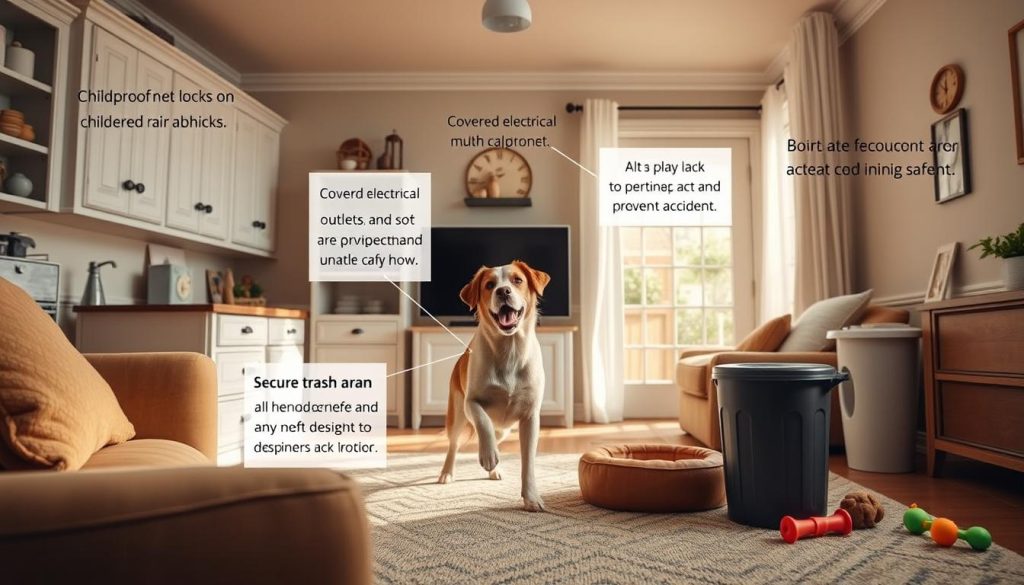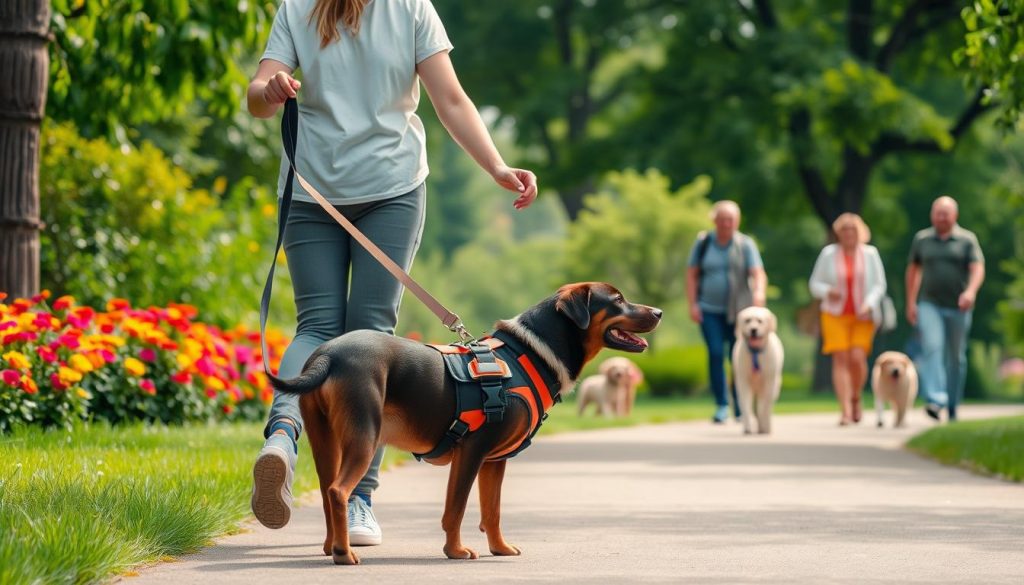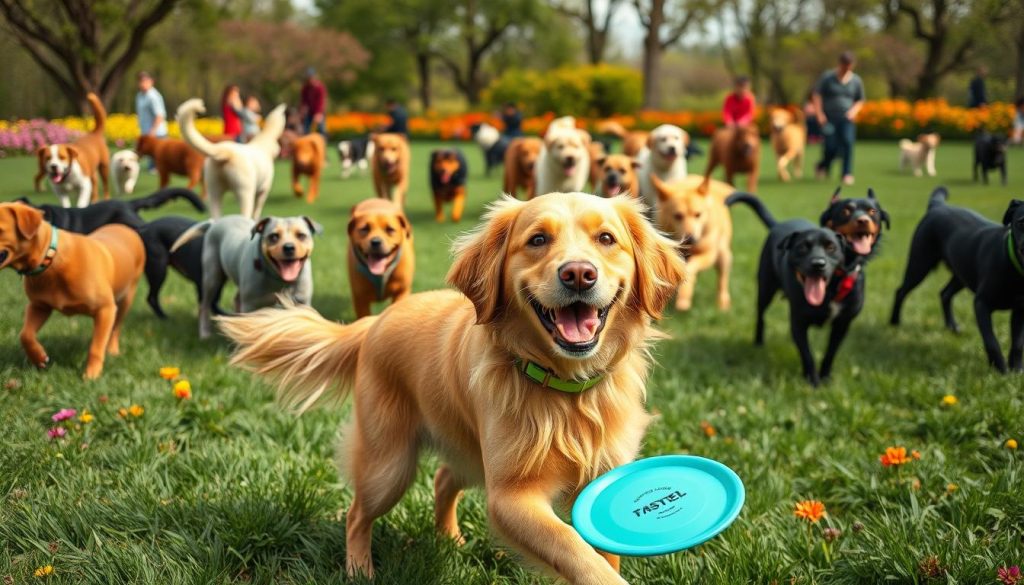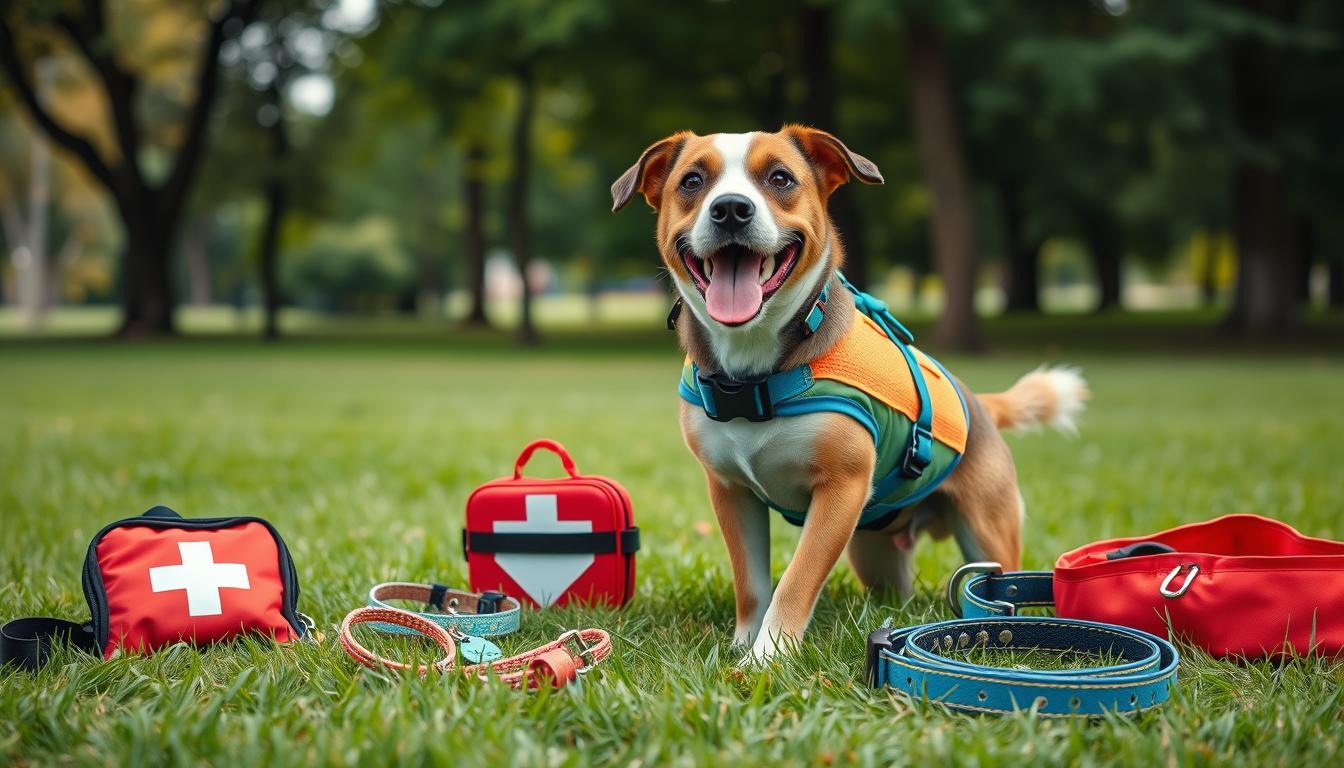As a devoted pet owner, I know how crucial it is to keep my furry friend safe. Dogs are more than pets; they are our family members. In this guide, I’ll share vital tips and advice to keep your dog safe at home and on adventures.
You’ll learn how to make your dog’s environment safe. We’ll cover how to navigate crowded places and keep your dog healthy. This guide is for all dog owners, new or experienced, to ensure your dog’s safety.
We’ll discuss the risks and hazards your dog might face. You’ll learn about leash training and preventive care. By the end, you’ll be ready to give your dog the best care, strengthening your bond and giving you peace of mind.
Introducing Dog Safety: Why It Matters
As a dog owner, keeping your pet safe is crucial. Dog safety is vital for your pet’s health and your responsibility as a pet parent. We’ll look at why your dog’s safety is important and the dangers they face.
The Importance of Prioritizing Your Furry Friend’s Well-being
Keeping your dog safe is key to being a good pet owner. By focusing on their safety, you create a safe and loving home for them. This helps prevent accidents and keeps your dog happy and healthy for a long time.
Understanding the Potential Risks and Hazards
As a dog owner, knowing the dangers is essential. Household dangers like toxic substances and electrical cords are risks. Outdoor threats, like other animals and bad weather, also need your attention. Ignoring these dangers can harm your dog’s health.
Knowing about dog safety and the dangers helps you protect your pet. Remember, your dog’s safety is your main concern. Taking the right steps ensures your dog lives a happy, healthy life.
Creating a Safe Environment at Home

As a pet parent, making sure your dog is safe at home is key. You need to dog-proof your living space to avoid accidents. Here, I’ll give you tips to make your home safe for your dog.
First, check your home for dangers. Look for things like electrical cords, sharp edges, and toxic plants from your dog’s view. Use baby gates or pet-proof fencing to block off risky areas. Also, hide or secure these dangers so your dog can’t get to them.
It’s important to keep dangerous items like chemicals and medicines safe. Store them in locked cabinets or on high shelves. Also, keep harmful foods away from your dog. This includes foods that are bad for them.
- Identify and secure potential hazards, such as electrical cords, sharp edges, and toxic plants.
- Use baby gates or pet-proof fencing to restrict access to high-risk areas.
- Store all household chemicals, medications, and toxic substances in locked cabinets or on high shelves.
- Keep human foods that are unsafe for dogs out of your dog’s reach.
Make your home comfy and fun for your dog. Give them lots of toys and puzzles. Also, get them comfy bedding and places to rest. This makes your home a happy and safe place for them.
| Household Hazards to Address | Solutions for Pet-Proofing |
|---|---|
| Electrical cords | Hide or secure cords out of reach |
| Sharp edges | Install corner guards or round off edges |
| Toxic houseplants | Remove or place plants in areas inaccessible to dogs |
| Household chemicals | Store in locked cabinets or on high shelves |
| Human foods | Keep off countertops and tables |
By following these tips, you can make your home safe and welcoming for your dog. This reduces the chance of accidents and keeps them happy and healthy. Keeping your dog safe at home is a big part of caring for them.
Dog Safety on Walks and Outdoor Adventures

Going outside with your dog can be fun. But, it’s important to keep them safe. This means teaching them to walk on a leash and how to handle crowds and cars.
Leash Training and Proper Equipment
Teaching your dog to walk on a leash is key. Spend time making sure they walk calmly by your side. Also, get them the right gear like a strong leash, harness, and ID tags.
Navigating Crowded Areas and Traffic
When you’re in public, watch where you are and keep your dog safe. Try to stay away from busy streets and choose quieter places. Always hold the leash tightly and be ready to move them away from dangers.
By focusing on safety, you can have fun walks with your dog. A bit of planning and watching out for them can make sure they’re happy and safe.
| Leash Training Tips | Navigating Crowded Areas |
|---|---|
|
|
Keeping Your Dog Healthy and Injury-Free

Keeping your dog healthy and safe is very important. Regular vet visits and care help a lot. They keep your dog in great shape and lower the chance of accidents and sickness.
Regular Veterinary Check-ups and Preventive Care
Regular vet visits are key for pet owners. They let your vet check your dog’s dog health and safety. They can spot problems early and give the right dog preventive medicine.
Preventive care is also crucial. It includes things like vaccinations and stopping parasites. These steps help keep your dog safe and preventing dog injuries.
It’s also important to focus on your dog’s dog wellness. Keep up with their diet and exercise. Also, talk to your vet about any behavior issues. This way, you can make sure your dog stays healthy and happy.
| Preventive Care Measure | Benefit |
|---|---|
| Routine Vaccinations | Protect against potentially life-threatening diseases |
| Parasite Prevention | Prevent the spread of internal and external parasites |
| Dental Cleanings | Maintain oral health and prevent dental disease |
| Nutritional Counseling | Ensure your dog receives a balanced and appropriate diet |
By focusing on your dog’s health and safety, you can keep them happy and healthy. Regular vet visits and care are key to a long, injury-free life for your dog.
Dog Safety During Emergencies and Natural Disasters
When emergencies or natural disasters happen, pet owners must be ready to keep their pets safe. It’s important to have a detailed emergency plan for your dog’s safety. This plan helps keep your furry friend safe during these unexpected times.
To start, make a pet safety kit. It should have your dog’s food, water, medicines, first aid, and ID. Also, keep a recent photo of your dog ready, in case you need to look for them.
If a natural disaster hits, you might need to leave your home. Make sure you can safely move your pet in a carrier or with a leash. Look up pet-friendly places to stay and know the best evacuation routes.
- Assemble a comprehensive pet safety kit, including food, water, medications, and identification documents.
- Develop an emergency plan for evacuating your home, including identifying pet-friendly shelters or hotels.
- Stay informed about local emergency protocols and be prepared to act quickly in the event of a disaster.
By being proactive, you can keep your dog safe during emergencies and natural disasters. Emergency preparedness for dog owners is key. And disaster planning for pets should always be a priority.
Dog Safety Around Children and Strangers
Keeping your dog safe is important everywhere, not just at home. It’s key to think about their safety when they meet kids and strangers. With the right steps, you can make sure your dog, family, and community are all safe and happy together.
Teaching Children How to Interact with Dogs
Kids are naturally curious, which can sometimes lead to risks when they meet dogs. As a pet owner, it’s your duty to teach them how to safely interact with your dog. Here are some tips to start with:
- Always ask the dog’s owner for permission before petting or interacting with the animal.
- Avoid making sudden movements or loud noises around the dog, as this can startle and unnerve them.
- Gently offer your hand for the dog to sniff before attempting to pet them, and avoid direct eye contact, which can be perceived as a threat.
- Never disturb a dog that is sleeping, eating, or caring for puppies, as these situations can provoke a defensive response.
Teaching these rules will help keep your dog and kids safe. It also helps them learn to live together peacefully.
Managing Your Dog’s Behavior Around Strangers
Dogs may feel scared or protective when they meet new people. To keep them safe, it’s important to train them to stay calm in public. Here are some tips:
- Expose your dog to a variety of people and situations, allowing them to become comfortable and confident in various environments.
- Reinforce obedience commands, such as “sit,” “stay,” and “leave it,” to ensure your dog responds appropriately when meeting new people.
- Avoid rewarding or encouraging your dog’s anxious or aggressive behaviors, as this can inadvertently reinforce the undesirable conduct.
By teaching kids about dog safety and controlling your dog’s behavior, you’ll create a safe space for everyone.
Dog Safety: A Comprehensive Approach
Keeping your dog safe needs a holistic approach. This means using all the safety tips from this guide. As a caring dog owner, making your pet’s safety a top priority is key. This way, you ensure their health, happiness, and safety are always first.
It’s important to tackle dog safety from all angles. This includes making your home safe and being careful when you’re out with your dog. By being proactive about risks, you show you care deeply about your dog’s well-being. This gives you peace of mind and makes you a better, more alert dog parent.
Dog safety is a big part of being a good pet owner. By using the tips from this guide, you can make sure your dog is safe and happy. Remember, keeping your dog safe is a team effort. By being involved, you’re not just protecting your pet. You’re also building a stronger bond with them.

